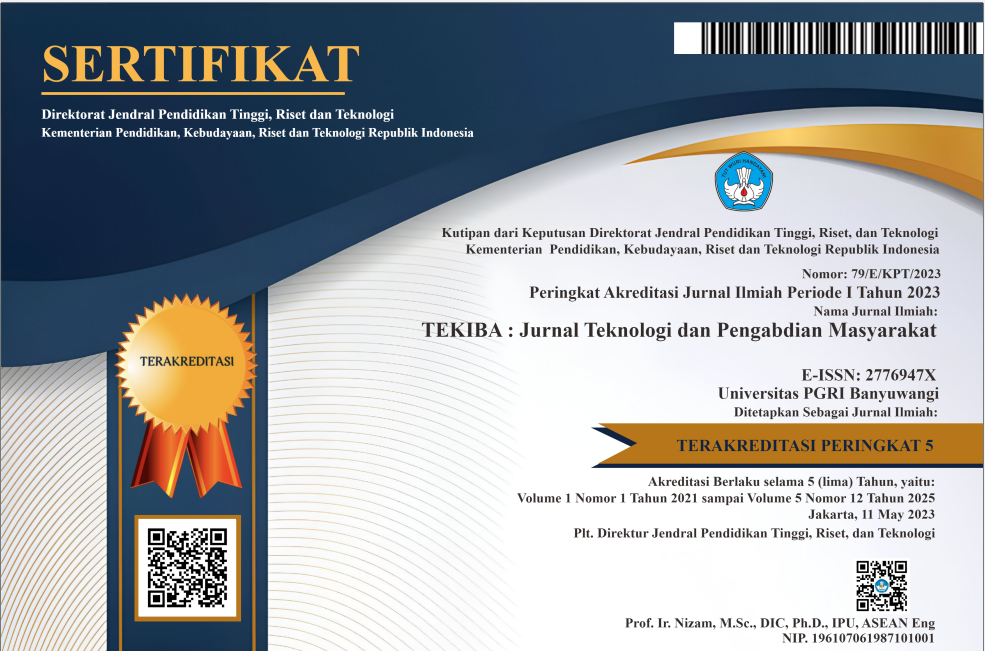Wisata Edukasi Mandiri Energi Menggunakan PLTS dan PLTB di Pantai Ria Bomo Kabupaten Banyuwangi
DOI:
https://doi.org/10.36526/tekiba.v2i2.2226Keywords:
Educational Tourism, Ria Bomo Beach, PLTS, PLTB.Abstract
Abstract – This paper describes the concept of energy independent educational tourism on Ria Bomo beach, Banyuwangi. Educational tourism is implemented to help the community's economy after the COVID-19 pandemic. The decline in post-pandemic tourists from 35,035 to 689 visitors, so that it has an impact on MSME business actors and tourism managers. Therefore, the community service team proposed the use of natural resources by implementing PLTS and PLTB as an effort to encourage business actors. The application of PLTS and PLTB is conceptualized as an education for tourists visiting Ria Bomo beach. The results of applying the concept show that the increase in tourist visitors is 10% on Monday-Friday. While tourist visitors on Saturday-Sunday to 20%. This concept is applied for education and piloting at beach destinations throughout Banyuwangi Regency.
References
[2] C. Nafisah, “Pengelompokan Kabupaten/Kota Di Jawa Timur Berdasarkan Jenis Daya Tarik Wisata menggunakan Analisis Custer,” 2018.
[3] M. Idris and S. T. S. L. A, “Strategi Pengembangan Pariwisata ( Wisata Pantai Balekambang ) Guna Meningkatkan Kunjungan Wisatawan di Kabupaten Malang,” Teknol. dan Manaj. Ind., vol. 2, no. 2, p. 6, 2016.
[4] A. Agustanya, “Pengembangan Objek dan Daya Tarik Pantai Kenjeran Sebagai Daerah Tujuan Wisata di Jawa Timur (Studi Kasus di Dinas Kebudayaan dan Pariwisata Kota Surabaya,” pp. 1–6, 2020.
[5] N. S. Agustin and A. F. Syah, “Analisis Perubahan Garis Pantai Di Pulau Madura Menggunakan Citra Satelit Landsat 8,” Juv. Ilm. Kelaut. dan Perikan., vol. 1, no. 3, pp. 427–436, 2020.
[6] M. I. Joesidawati, “Klasifikasi pantai di pesisir tuban jawa timur,” Semin. Nas. Pendidik. dan Kelaut. VI, no. May 2016, pp. 1–6, 2016.
[7] S. Suyarso, “Dinamika dan Evolusi Pantai Probolinggo, Jawa Timur,” OLDI (Oseanologi dan Limnol. di Indones., vol. 1, no. 1, p. 19, 2016.
[8] P. Banyuwangi, C. Cynthia, and L. Kristanto, “Pusat Informasi Kebudayaan dan Pariwisata Banyuwangi di Banyuwangi,” vol. V, no. 1, pp. 233–240, 2017.
[9] PBS, “Statistik Pariwisata Provinsi Jawa Timur 2021,” Surabaya, 2021.
[10] T. Erwandi, “Kabupaten Banyuwangi Dalam Angka,” 2022.
[11] D. Imaniar and A. Wahyudiono, “Strategi Pemerintah Kabupaten Banyuwangi Dalam Meningkatkan Industri Pariwisata Melalui Usaha Mikro Kecil Menengah (Umkm),” Reformasi, vol. 9, no. 2, p. 90, 2019.
[12] P. W. P. Suta and I. G. A. O. Mahagangga, “Pengembangan Pariwisata Berbasis Masyarakat,” J. Destin. Pariwisata, vol. 5, no. 1, p. 144, 2018.
[13] H. Al Ghifari, I. B. Prasetyawan, and W. Atmodjo, “Kajian Potensi Energi Pasang Surut Di Pantai Waru Doyong Kabupaten Banyuwangi,” J. Oseanografi, vol. 6, no. 3, pp. 456–466, 2017.
[14] I. Abdullah, J. Nurdin, and J. Teknik Mesin, “Kajian Potensi Energi Angin di Daerah Kawasan Pesisir Pantai Serdang Bedagi Untuk Menghasilkan Energi Listrik,” Tek. Mesin ITM, vol. 2, no. 1, pp. 31–38, 2016.
[15] M. E. Murniati, “Analisis Potensi Energi Angin Sebagai Pembangkit Enegi Listrik Tenaga Angin Di Daerah Banyuwangi Kota Menggunakan Database Online-BMKG,” J. Surya Energy, vol. 6, no. 1, pp. 9–16, 2022.
[16] P. W. Andianti and Yushardi, “Potensi Pembangkit Listrik Tenaga Angin Sebagai Alternatif Penerangan Jalan di Pantai Bambang Kabupaten Lumajang,” J. Ilm. Pariwistas Agama dan Budaya, vol. 7, no. 2, pp. 1–8, 2022.
[17] S. Sudarti and F. A. Dani, “Potensi Pembangkit Listrik Tenaga Angin di Pantai Blimbingsari Kabupaten Banyuwangi,” CIRCUIT J. Ilm. Pendidik. Tek. Elektro, vol. 5, no. 2, p. 93, 2021.
[18] M. Ariandi, “Pengujian Performa Kerja PLTS Dan PLTB Menggunakan Parameter Suhu Dan Kecepatan Angin,” J. Ekon. Vol. 18, Nomor 1 Maret201, vol. 2, no. 1, pp. 41–49, 2020.
[19] T. P. BMTI, “Aplikasi plts teknik energi terbarukan – gambar teknik energi surya dan angin 1,” p. 244, 2015.
[20] R. Hidayat and J. Fadil, “Modul Pembangkit Listrik Tenaga Surya Untuk Aplikasi Beban Rendah ( 600 W ),” vol. 17, no. 1, pp. 29–36, 2017.
Downloads
Published
Issue
Section
License
Copyright (c) 2022 Adi Mulyadi, Adi Pratama Putra, Meghandi Gusti Wardhana, Rezki Nalandari, Aan Mutowib

This work is licensed under a Creative Commons Attribution-ShareAlike 4.0 International License.









